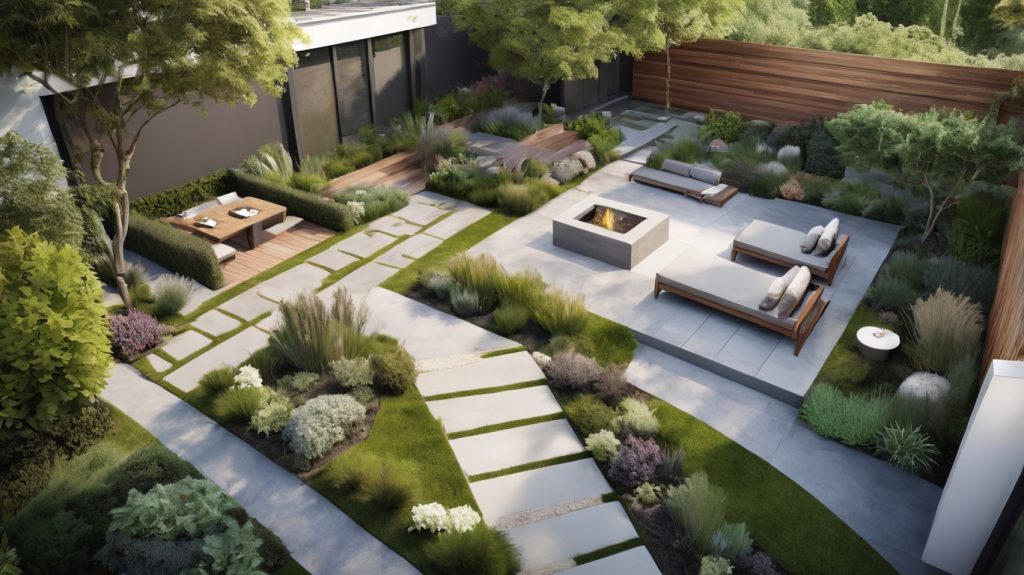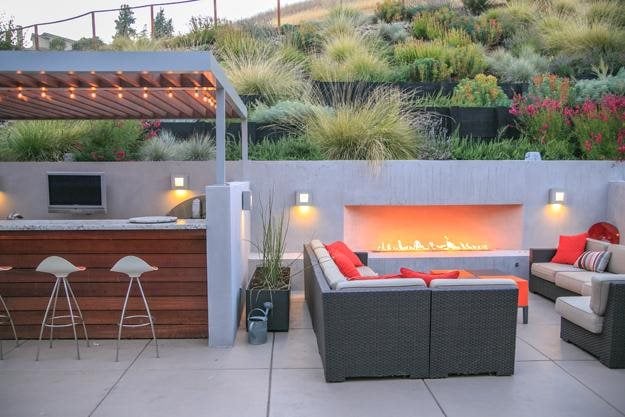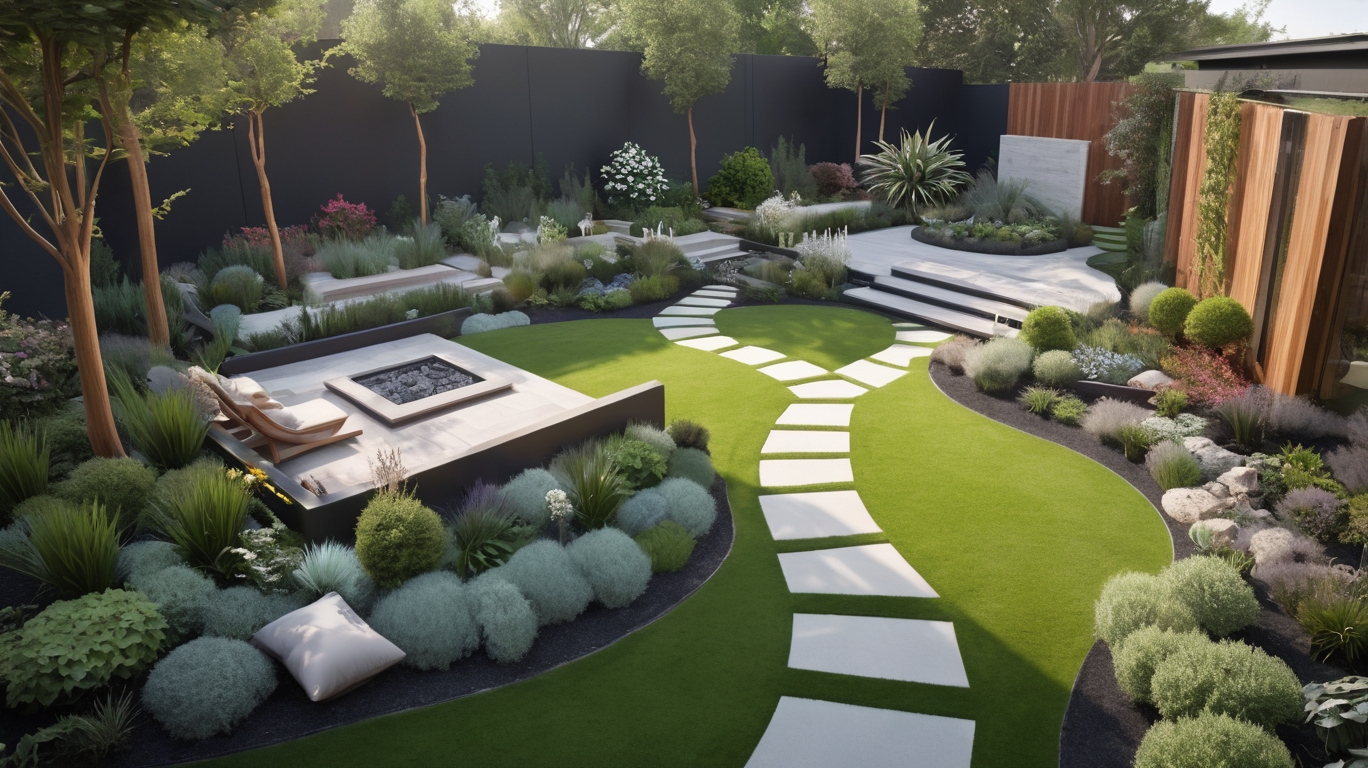Gardening has evolved dramatically. Modern garden designs offer fresh, creative ideas.
In today’s fast-paced world, a garden serves as a peaceful retreat. Modern garden design embraces simplicity, functionality, and beauty. It’s not just about plants; it’s about creating a space that reflects your style. You can blend minimalism with nature, use sleek materials, and incorporate innovative features like water elements and smart lighting.
Whether you have a small balcony or a spacious backyard, modern garden design ideas can transform your outdoor space into a stunning oasis. Dive in to discover how you can bring a touch of modern elegance to your garden.
Minimalist Garden
The Minimalist Garden is a modern approach to landscaping that emphasizes simplicity and functionality. This garden style focuses on clean lines, neutral colors, and a clutter-free environment. The goal is to create a serene and peaceful outdoor space that is easy to maintain. The minimalist garden design is perfect for those who appreciate a sleek and contemporary look.
Clean Lines
Clean lines are a key feature of a minimalist garden. They create a sense of order and structure. Straight pathways, geometric shapes, and well-defined edges are commonly used. This design element helps to make the garden look tidy and organized. It also enhances the feeling of spaciousness in the garden.
Use materials like concrete, stone, or wood for pathways and borders. These materials add to the modern aesthetic. Avoid using too many curves or intricate patterns, as they can make the space feel cluttered. Instead, focus on simple and straight lines to achieve a clean and minimalist look.
Neutral Colors
Neutral colors play a significant role in minimalist garden design. These colors create a calm and soothing atmosphere. Shades of white, gray, beige, and black are often used. These colors help to highlight the natural beauty of the plants and other garden elements.
A neutral color palette also makes the garden look more cohesive and harmonious. You can use different shades of the same color to add depth and interest. For example, different tones of gray can be used for pathways, planters, and furniture. This approach ensures that the garden looks elegant and understated.
Plants with green foliage are ideal for a minimalist garden. They complement the neutral colors and add a touch of freshness. You can also use plants with white or pale flowers to enhance the serene ambiance. Avoid using too many bright or bold colors, as they can disrupt the calm and peaceful vibe.

Vertical Gardens
Vertical gardens are a beautiful way to use small outdoor spaces. They allow you to grow more plants in less space. This idea is perfect for city dwellers with limited room. It also adds a lush, green touch to any urban setting. Two popular methods are wall planters and climbing plants.
Wall Planters
Wall planters are an excellent choice for vertical gardens. They come in many styles and materials. You can use them to create a green wall. Here are some benefits:
- Space-saving: Ideal for balconies or small yards.
- Versatile: Suitable for flowers, herbs, and even vegetables.
- Aesthetic appeal: Adds beauty and texture to plain walls.
Wall planters can be made of wood, metal, or plastic. They come in different shapes and sizes. You can mix and match to create a unique design. Here is a table to compare some popular wall planters:
| Type | Material | Best For |
|---|---|---|
| Hanging Pots | Ceramic | Flowers |
| Vertical Pallet | Wood | Herbs |
| Wall Pockets | Fabric | Succulents |
Climbing Plants
Climbing plants are another wonderful way to create a vertical garden. They grow upwards and can cover walls or fences. This provides a lush, green backdrop. Some popular climbing plants include:
- Ivy: Fast-growing and evergreen.
- Jasmine: Fragrant and beautiful.
- Bougainvillea: Colorful and vibrant.
These plants can be trained to climb using trellises or wires. They provide shade and privacy. Plus, they are great for attracting birds and insects. Climbing plants add a natural charm to any garden.
Sustainable Gardening
Sustainable gardening is a growing trend in modern garden design. It focuses on creating eco-friendly spaces that conserve resources. This approach benefits the environment and enhances the beauty of your garden. Let’s explore some sustainable gardening ideas.
Native Plants
Using native plants is a key aspect of sustainable gardening. These plants are adapted to the local climate and soil. They require less water and fewer chemicals. Native plants attract local wildlife like birds and butterflies. They also reduce the need for fertilizers and pesticides. This makes your garden both beautiful and environmentally friendly.
Rainwater Harvesting
Rainwater harvesting is another sustainable gardening technique. It involves collecting rainwater for garden use. This method conserves water and reduces your water bill. Install a rain barrel under your downspout to collect rainwater. Use this water to irrigate your plants. It’s an easy and effective way to promote sustainability in your garden.
Outdoor Living Spaces
Creating outdoor living spaces can transform your garden into a cozy retreat. These areas serve as extensions of your home, offering a place to relax and entertain. Modern garden design ideas focus on combining style and functionality.
Comfortable Seating
Comfortable seating is essential for any outdoor living space. Select weather-resistant furniture with plush cushions. Arrange chairs and sofas to encourage conversation. Adding a few decorative pillows can enhance the comfort and aesthetics. Consider installing a hammock or a swing for a touch of fun.
Outdoor Kitchens
Outdoor kitchens are gaining popularity in modern garden designs. They allow you to cook and dine in the fresh air. Start with a basic grill and expand as needed. Include counter space for preparation and storage. A mini-fridge can keep drinks cold. Install proper lighting for evening use. This creates a perfect spot for family gatherings and parties.
Water Features
Water features can transform a garden into a serene retreat. They add sound, movement, and a touch of elegance. Here are some modern garden design ideas focusing on water features.
Modern Fountains
Modern fountains are sleek and stylish. They can be the centerpiece of your garden. Choose a minimalist design for a contemporary look. Stainless steel and glass materials are popular choices. They reflect light beautifully.
Consider the following options:
- Wall-mounted fountains: Perfect for small spaces.
- Tiered fountains: Add height and elegance.
- Solar-powered fountains: Eco-friendly and easy to maintain.
Modern fountains not only look great but also provide soothing sounds. They can create a peaceful ambiance in any garden.
Reflecting Pools
Reflecting pools are another stunning water feature. They create a sense of calm and stillness. The water’s surface reflects the surroundings, enhancing the garden’s beauty. Reflecting pools often have simple, clean lines. This makes them ideal for modern gardens.
Consider these design elements:
- Rectangular or square shapes: Classic and modern.
- Dark-colored liners: Enhance reflections.
- Surrounding plants: Add a natural touch.
Reflecting pools work well in both large and small gardens. They can be placed near seating areas or as a focal point. They provide a mirror-like surface, creating a stunning visual effect.
Lighting Solutions
Lighting solutions can transform your garden into a magical space. The right lighting enhances beauty, creates ambiance, and improves safety. Here are modern garden design ideas focusing on lighting solutions.
Pathway Lights
Pathway lights guide guests and add style to your garden. These lights can be solar-powered or wired. Solar-powered lights are eco-friendly and easy to install. Wired lights provide a consistent glow. Choose low-voltage options for energy efficiency.
Pathway lights come in various designs. Use stake lights for a classic look. Or, try LED strips for a modern touch. Place lights at regular intervals for a balanced effect. Ensure the lighting is soft to avoid glare.
Ambient Lighting
Ambient lighting creates a warm and inviting atmosphere. Use string lights to drape trees or pergolas. Lanterns and fairy lights add a whimsical touch. Battery-operated options offer flexibility and ease of use.
Consider using uplights to highlight garden features. Place them at the base of trees or sculptures. This adds depth and drama. LED candles are another great option. They provide a soft, flickering light without the risk of fire.
Combine different types of ambient lighting for a layered effect. This creates a cozy and enchanting garden space.
Edible Gardens
Edible gardens are a wonderful addition to any modern garden design. They provide fresh produce right at your doorstep. These gardens are both functional and beautiful. You can grow herbs, vegetables, and fruits. This way, you enjoy fresh flavors and a vibrant garden.
Herb Gardens
Herb gardens are a favorite for many gardeners. They are easy to maintain and look lovely. You can plant herbs like basil, thyme, and rosemary. These herbs add flavor to your dishes. They also give a pleasant aroma to your garden. Herb gardens can be grown in pots, raised beds, or even window boxes. This makes them versatile and suitable for small spaces.
Vegetable Beds
Vegetable beds offer a way to grow your own food. They can be simple or elaborate. Common vegetables to grow include tomatoes, carrots, and lettuce. Raised beds are a popular choice. They provide better drainage and soil quality. This leads to healthier plants and a higher yield. You can also use companion planting. This method helps protect plants from pests and improves growth.

Credit: www.gardendesign.com
Zen Gardens
Zen gardens, also known as Japanese rock gardens, offer a tranquil escape. They create a peaceful space with simple designs. These gardens focus on minimalism and balance. They use natural elements such as sand, gravel, and stones.
Sand And Gravel
Sand and gravel are key components in Zen gardens. They represent water and waves. The patterns in the sand can be calming. They can also change with your mood or season. Use a rake to create different designs. This process can be meditative.
White gravel is often used to add brightness. It contrasts with the darker stones. Gray gravel can provide a more subdued look. Both options work well in any Zen garden. Consider adding larger stones to mimic islands.
Minimalist Plants
Minimalist plants enhance the simplicity of Zen gardens. Bamboo, moss, and small shrubs are popular choices. They require little maintenance and add to the serene atmosphere. Bamboo can be used as a backdrop or screen. Moss grows well in shady areas and provides a soft, green carpet.
Small shrubs like Japanese maples add color and structure. Choose plants that thrive in your local climate. Keep the arrangement simple and uncluttered. This ensures the garden remains peaceful and easy to maintain.
Incorporate a few well-placed plants. This helps to maintain the garden’s minimalistic design. Avoid overcrowding the space. Remember, less is more in Zen gardens.

Credit: id.pinterest.com
Frequently Asked Questions
What Is Modern Garden Design?
Modern garden design focuses on clean lines, minimalism, and functional spaces. It often incorporates contemporary materials and sustainable practices.
How Do I Create A Modern Garden?
Start with a simple layout. Use sleek materials like concrete and metal. Incorporate native plants for sustainability.
What Plants Are Ideal For Modern Gardens?
Choose low-maintenance, structural plants like succulents, ornamental grasses, and evergreens. They add texture and form.
How Can Lighting Enhance Modern Gardens?
Use LED lights for pathways, accentuate key features, and create ambiance. It enhances safety and aesthetics.
Conclusion
Transform your garden into a modern haven with these design ideas. Try different styles to find your favorite. Use minimalist furniture for a sleek look. Add vibrant plants for color and life. Don’t forget practical elements like lighting. Small changes make a big impact.

Leave a Reply